Monday, September 30, 2013
Northern Ireland Map Issue
The simple fact is Northern Ireland was separated from Ireland because of its Scot-English majority. The basic rule of thumb was to get majority Scot-English areas in the United Kingdom and majority Irish areas in Ireland. On the map the majority Protestant areas give a basic outline of the territory.
Factors involved in the green areas on the map, where Irish Catholics are in the majority, are several. 1. Islands of Ireland within Northern Ireland would not be strategically acceptable. 2. The big sort of thumb up the center would also raise strategic problems. 3. The areas along the southern border have near Scot-English Protestant majorities and have significant ownership of land and business by that group. 4. Urban areas, like Derry/Londonderry were too valued to cede.
We should note that getting ethnic peoples in their proper area, nation, country was a major theme in post World War I Europe. Making sure the Germans were in Germany and Italians in Italy, etc., was part of the peace process. committees in the process went down to the farmstead level to ensure people were in the right nation. That this cannot be done perfectly is one of the issues leading to World War II. Hitler saw Germans in ethnic areas outside Germany as deprived and bringing them into the German state was a major goal. The Sudetenland is a prime example of this concept being used. Especially islands of another group, or minorities of another group, became a battle cry.
Lawrence of Arabia and Deserts
David Lean's Lawrence of Arabia [1962] is the top movie for capturing the nature of the desert. While desert varies, the dry desert that people take to mind upon hearing "desert" s found in scenes from this film. Shot on location, Lawrence (Peter O'Toole) has just met Sherif Ali (Omar Sharif) in the desert of Western Arabia (Saudi Arabia now). In this scene we see the dryness of the desert and the vast sands that the dry desert will tend to have. David Lean (Director) captures these feature in this single scene.
Do play it to the largest screen you can show it on. That vastness just stands out.
Friday, September 20, 2013
Ireland and Northern Ireland
When one looks at Ireland, one notices that the Northeast corner is not a part of Ireland. It is in fact part of the United Kingdom (as are England, Scotland, Wales and several islands). This separation has a long history going back to 1169 when Henry II of England became involved in a battle between two Irish tribal groups. After receiving some right to claim land, the English lightly settled the area around Dublin in an area known as The Pale. In 1541 Henry VIII proclaimed himself King of Ireland as the Irish were rather disorganized tribes at the time. Just into the 1600s Elizabeth I began settlement programs moving Scots and English into Ireland. The Catholic Irish could not be trusted during a time when catholic versus Protestant was the rule of battle in Europe. Much of this program displaced the Irish farm from his/her land.
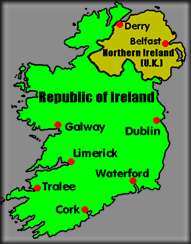 The building of a sense of being Irish and Irish unity begins to build over the next century. This is a bitter period for the Irish as they are Britain's first colony. The Irish basically lose ownership of their own land to the English and Scots. They are subjected to hardships including the Potato famine in the 1840s which leads many to flee to England or the United States. One issue in this is that the British insist that the Irish become Protestant. In refusing to convert this takes on a religious tone of Protestant versus Catholic.
The building of a sense of being Irish and Irish unity begins to build over the next century. This is a bitter period for the Irish as they are Britain's first colony. The Irish basically lose ownership of their own land to the English and Scots. They are subjected to hardships including the Potato famine in the 1840s which leads many to flee to England or the United States. One issue in this is that the British insist that the Irish become Protestant. In refusing to convert this takes on a religious tone of Protestant versus Catholic.
The Irish gain freedom for the currently Ireland part of the island in 1921 after a rising against the British. The British kept the Northeast part known as Ulster because they had settle an English and Scot majority in that area over the years, and had major investments in industries around Belfast.
Attempts to get a revolt going in the late 1950s fail, but a civil rights movement organizes in the North in 1969. The Catholic Irish in the North are subject to discrimination as groups are/were in the United States and other places. They push for rights, but this breaks down into a several decade struggle involving significant acts of terrorism from both sides and many injuries and deaths. Starting in 1995 and 1998 peace agreements have brought basic peace to Northern Ireland, but it remains a part of the United Kingdom. Given the Protestant (English, Scot) majority, it is likely to remain for years to come.
A Very Select Bibliography
Aalen, F. H. A. 1978. Man and the Landscape in Ireland. London, England, UK: Academic Press. A discussion of Irish history.
Bailly, Derek. 1990. Frontiers. The Footsteps of Man. Videotape. London, England, UK
Baol. F. W. 1980. Two nations in Ireland. Antipode 11: 38- 40.
Munn, Brain. 1989. A History of Ireland. PBS Video Series. Washington. DC: Public Broadcasting Service.
Police History. 2002. Map: Ireland. Internet. www.policehistory.utvinternet.com
Tuesday, September 17, 2013
Tropes
Media Studies people are now beginning to use the word “trope” to refer to those items TV and other media people use to call upon elements the audience already generally knows to bring them into the story. As the site TVtropes says: “Tropes are devices and conventions that a writer can reasonably rely on as being present in the audience members' minds and expectations. On the whole, tropes are not clichés. The word clichéd means "stereotyped and trite." In other words, dull and uninteresting. We are not looking for dull and uninteresting entries. We are here to recognize tropes and play with them, not to make fun of them.” [Source: TV Tropes http://tvtropes.org/pmwiki/pmwiki.php/Main/HomePage] Or, Anita Sarkeesian of Feminist Frequency defines a troupe as “A troupe is a common pattern in a story or recognizable attribute in a character that conveys information to the audience.”
For geographers the term would include the place elements used by media people. How is a story of California or New York City told among media presentations. Heavy crime in New York city would be a trope used by many shows to create believability among the viewers. The image part of the standards would relate to tropes. The South Pacific as paradise is a trope.
Sunday, September 15, 2013
Stamps Tell the Story of a Place: Maldives
Stamp collecting is a hobby that takes you out into the world and gets you connected to other places. Stamps are more than just postage, they carry messages about people and what they are like and what they value. Most stamp collectors and clubs are ready to help young people get going in the hobby, so find one and have that collector show you how the hobby works.
To show this let me take the example of the Maldives. Islands just southwest of India, they are rather unknown by most people. What can be learned about them by stamp collecting?
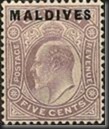
They once were British colonies and would have some ties to Britain today. The stamp above is indicative of the method by which colonies picked up post offices. Early colonial stamps were often from other colonies (Ceylon, now Sri Lanka, in this case) or the colonial power with a new colonies' name imprinted on the top. Especially when using stamps from the colonial power they marked the outside influence, as in the King here.

This is the first local stamp from 1908. Note the Middle Eastern looking tower (Minaret of Juma Mosque) and the four languages on the stamp. This shows some cross-cultural nature to the islands. Obviously the colonial power is shown (by the English), but Arabic and other South Asian languages indicate involvement with India and the fact that the Maldives are Islamic. Islam arrived as part of the giant spread of the faith in the centuries after the times of Mohammed. with Islam came Arabic.
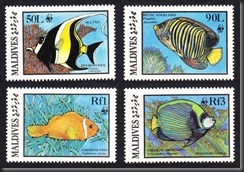
The physical side is illustrated by this stamp of tropical fish. They have a number of fish oriented issues. Being islands fish are likely a major local food. Other elements show would be such as trees, butterflies, and birds. The physical environment is important as tourism is a major business. They have pristine beaches with wide ocean views.
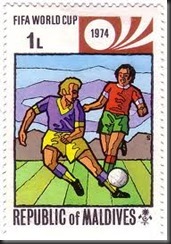
Soccer on this stamp indicates a British time, or at least European. elements of culture show up on stamps. The major local game is taken from Europe. The culture was once dominated by the British.
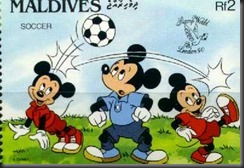
On a different track is the fact that many small nations with limited industrial opportunities sell stamps to collectors on a wide variety of topics. Many of these have nothing to do with the Maldives or that other spots, but they are exploiting the topical interests of stamp collectors to raise money. Mickey Mouse is not theirs, but many collectors exist who buy anything Mickey. The same is true of Elvis, living presidents of the US, princess Diana, and a wide list of general things like, nude art, movie stars, birds, fish, and such.
So just by looking at a countries' stamps, you have a geography unit in the making. Some might find a lifelong hobby that puts foreign places right in front of you. You can certainly find geographers who got their interest in the field by collecting stamps and learning where all those strange places were.
Saturday, September 7, 2013
Onsen
Bathing is very important in Japanese culture. The Onsen or sento is the place to do this. While private bathing is growing, 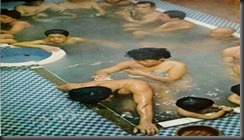 the bath is a public experience. The volcanic nature of Japan has allowed readily available hot warm.
the bath is a public experience. The volcanic nature of Japan has allowed readily available hot warm.
Bathing traditionally has been with mixed sexes, but law now allows separation. relaxation and conversation are open parts of this process. You meet people and can just be along to think/mediate, too.
The process is to clean yourself first, then use the bath to soak and meditate or talk. One talks with relatives, friends, or just those present.. The social class rules are suspended as the bath is a meeting zone for people of all classes. One is to clean and purify the body to communicate with the gods who rest in nature. These two processes are separated. To enter the bath to clean like we do would be a social error in Japan.
The water must be hot. Temperatures are in the range of 105 or more so the skin gets red.
The Maldives
The Maldives are a group of islands off the coast of India in the Indian Ocean. They are not well known to most people. Scuba and skin divers would be the biggest audience having some familiarity with them. YouTube has a number of short clips to show them off.
The Maldives have a maximum rise of 7 feet above sea level. The average elevation is only 3 feet. They are coral reefs.
They must import most of their foods as there is little space for agriculture. They do export some clothing.
For interaction and integration with us they are a tourist spot, mostly for scuba and  skin divers. They have wonderful beaches and the diving conditions are super. The other item of interaction and integration, and the most likely place for them in your curriculum, is that they are on the front lines for damage from global warming. If the oceans rise only a few feet they have little that can be done to save them. If you are only a maximum of seven feet out of the water, you are first in line for trouble if ocean levels rise. A place to know.
skin divers. They have wonderful beaches and the diving conditions are super. The other item of interaction and integration, and the most likely place for them in your curriculum, is that they are on the front lines for damage from global warming. If the oceans rise only a few feet they have little that can be done to save them. If you are only a maximum of seven feet out of the water, you are first in line for trouble if ocean levels rise. A place to know.